#rs: attempt the impossible
Text

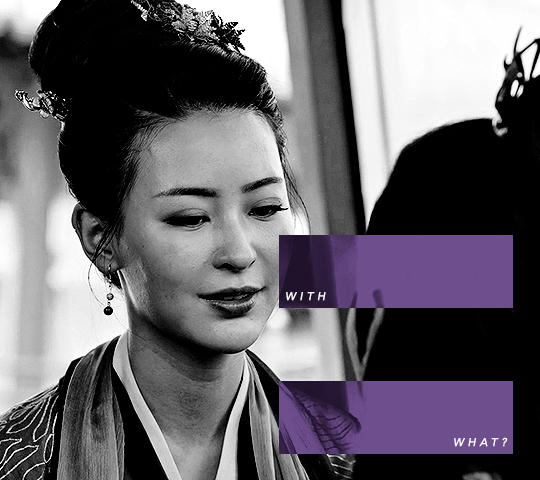

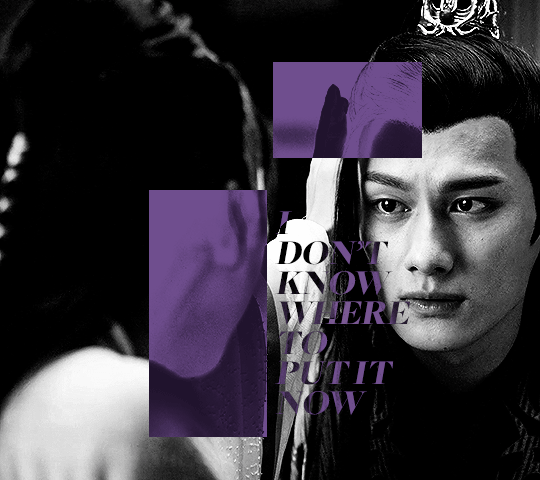

FLEABAG — season two, episode four
+ jiang cheng, his family, and jin ling
requested by @spriteofmushrooms - insp
#it's one gifset michael how long can it take to make..... seven months?#theuntamededit#cqledit#dramasource#cdramaedit#dailyasiandramas#cdramsource#chineseartistsinc#asiandramasource#jiang cheng#jin ling#jiang yanli#wei wuxian#yu ziyuan#jiang fengmian#the untamed#fdstuff#rs: the one who loves him the most#rs: attempt the impossible#requests.#this was like pulling teeth not because it was a hard request but because i instantly had a very specific vision in my mind when i read#your message and then it became immediately clear that i did not have the skills or knowledge required to make it come to life#so it was just me fighting against settling. if i had to compromise i wanted it as close to what was in my mind as possible#lmao anyway this is it! i know it's a bit messy but close your eyes and imagine the version of it i had in my head
685 notes
·
View notes
Text
A little addition to "Curious"
“D’aw and yet here ye are unable to live wi’out me”
Robyn rolled his eyes as a smile began tugging on the corners of his mouth. There was some truth to it. Micah was his best friend, the person he’d trust with his life and imagining a life without those red curls, trilled Rs and filthy tongue was impossible. At the very least, Robyn thought, it would be a rather unhappy life without Micah.
As he stared at the ceiling of the barn the thoughts came rushing back. Endless trains of thoughts pulling him from one question to the next. That was nothing new. His mind was always restless and always made it difficult for him to concentrate on something fully for a longer amount of time. It’s been this way since his childhood but this train of thoughts was different somehow. Vivan’s words didn’t let him go. Who was his “somebody else”? What does Vivian know that he doesn’t? And instead of sitting and thinking of who it is, all his thoughts could be stilled with a little glimpse into a crystal ball. The solution is right there. And Robyn certainly didn’t care much for rules. He could ask someone else to take a look but…
Micah was right. Oracle magic is not to be underestimated and knowing your future may be more dangerous than one might think at first. And what if he does suddenly know who he’s going to be with? Wouldn’t it feel forced? Like it didn’t naturally develop but because “it must happen”. That would affect the whole relationship, no? Isn’t that the nice part about romance? That you yourself don’t know what will happen. That your unknowing will make the little things and the firsts of a relationship so much more meaningful? Even the kiss with Vivian has a meaning now that it wouldn’t have had in a case of knowing how she felt and that she will kiss him.
A bunch of hay suddenly poking his face ripped him out of his deep thoughts.
“Ey!”, he exclaimed disgusted. “Ew, Mike, what the heck?!”
“Oh, sorry, was that not the wheelbarrow? Oopsies.”, Micah grinned.
“You bastard-”, Robyn started grinning himself and stood up from the hay seat, gently pushing Eilidh’s (the unicorn) head off his laps, “-I’m gonna kick your ass.”
“Come and try, Shorty.”
“Alright that’s it!”
Robyn picked up small piles of hay and threw them at Micah, who dodged them without throwing anything back. Laughing and with another pile in his hands, Robyn approached Micah. The freckled boy however, held out the pitchfork to his attacker.
“Put the pitchfork down.”, Robyn halted smiling.
“Put the hay down.”, Micah replied, “Then we’ll talk ‘bouta pitchfork.”
“You’re a very unfair opponent, good Sir. You attacked me first! Now you’re using weapons I don’t have. Make it fair. Hay against hay.”
“Only if there’s ceasefire while I put it away.”
“You have my word.”
A moment of delay. Nothing happened as they both smirked at each other. Micah placed the tool on the ground and kicked it behind him, never once breaking the eye contact with the brunet.
“Good.”, Robyn tried to suppress his smile and be fully in the role of a dueling opponent, who would ensure to be on the winning side, “Now eat hay!”.
Micah dodged the hay attacks once again, still not throwing anything back. He instead attempted to flee, running around in the barn with Robyn right behind him. Both laughing heartily in this game of chase. Robyn chased after Micah for a good minute until Micah’s reflexes were too slow and gave Robyn the opportunity to pin him to the wooden wall by the shoulders.
“Where to now, Freckles?”, he smirked up at Micah.
Micah smiled, panting and catching his breath, trying to still his heart beat along with it.
“Alright, alright!”, he laughed, “I surrender.”.
Robyn didn’t give a response. He tried to catch his own breath and only managed to stare at Micah. Stare at his face as if he’s never seen the light brown freckles all over it or the reddish brown of his eyebrows and eyelashes. As if he looked at those golden eyes for the first time and as if he first notices the chunks of red hair falling into that pale face. As if this was the first time he noticed how beautiful all those traits were together. His breath calmed.
“Rob? Ye- uh… ye can let me go now.”.
Robyn blinked rapidly a few times and pulled himself out of his thoughts.
“Oh, yes, right. Sorry.”, he let go of Micah’s shoulders and backed away, “I uh.. I spaced out for a little there.”.
Micah chuckled. “I noticed. It’s alright.”.
The redhead looked around the hay-covered barn with a long uttered “Well”.
“We better get this cleaned up again before ma dad notices.”, he rubbed his neck.
“Yeeeaah”, Robyn chuckled, “Sorry about that too.”.
“Nonsense, I got myself into this literal mess. It was fun though.”, Micah turned and smiled at Robyn.
“It was.”.
Robyn picked up a broom from the corner of the barn. He better forget about whatever that intense stare of him just was. He wasn’t staring in that sense.
Right?
Micah was attractive to him. But that’s nothing new.
There wasn’t more to it.
…
Right?
#running late to work for this#tdaac#robyn clawthorne#micah bower#pls excuse any typos i had no time to proofread 😭
66 notes
·
View notes
Note
Hi, May I please request:
An unsub has reader as a hostage and JJ and the team have to negotiate to get her back safely, as they trade off, the unsub shoots reader in the neck (JJ shoots the unsub) but she survives. (JJ is rs wife, r is also a BAU agent.)
hostage
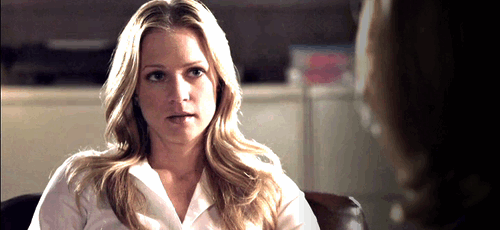
wc: 1.2k
pairing: jj x f!reader
warnings: rape insinuations, gun mentions, sexual assult insinuations, toxic (past) relationship mention, general assholery, reader gets beat up, reader is drugged, shooting, reader gets hurt, happy ending, un beta’d writing
a/n: i put elle on this team because i am a firm believer that elle would fight to the death for you bc she’s protective af and since jj is technically supposed to be on the sidelines, we need her. she doesn’t have a big appearance but she’s there. also, this guy was inspired by lewis from svu but hopefully he ended up not as creepy as him, its been a sec since i’ve made up an unsub for writing purposes
it wasn’t every day you found yourself being held hostage by a spree-killer.
you and the team had been hunting him for months, following him around the states, being lied to countless times by him and the people he knew until you found yourself in a dive bar he frequented out in alabama. you had to admit, you were a little nervous, but it was something you had handled before, you’d be fine. at least, you thought you would. but somehow he had drugged your drink, and you woke up in a place that was unfamiliar to you and a pain in your lower half that you hadn’t experienced before.
that was a week ago.
had it been a week ago? time had gotten so muddled since don - you can’t recall if that’s actually his name or not - had continuously pumped you with whatever low priced narcotic he found out on the street when he left you in the barren lake house. you could hear people outside sometimes, but you were so god damn tired you couldn’t find it in you to scream out for help. not anymore. you had already attempted to get out twice and he had caught you both times. the first time, he had gotten home earlier than you had anticipated and had beat you up so bad you still couldn’t see out of your left eye. the second time he had booby-trapped the front and back door, making it impossible for you to get out without falling into a trap, but you didn’t know that until you were actually in his trap.
you honestly would rather die than live another day here.
it was late on what you believed was day eight of your capture when you heard the rustling of don coming in through the front door, and you braced yourself for whatever it was that was going to happen. it wasn’t pretty. you had gotten used to the pain at this point, it had become a daily part of the routine. don would come back drunk and you were his toy that he could hit and shove and push around and do whatever he wanted to. you let him, knowing that if you fought back it would be the end of your life. and you couldn’t die without saying bye to your wife.
your wife. jj. the absolute love of your life. it had felt like years since you had last seen her, your last words to her being “it will be okay, i love you.”. it hurt you to think that you didn’t even say goodbye before leaving her. for all she knew, you were dead in a ditch and you didn’t even say goodbye. at the very moment, that hurt the most.
you missed her so fucking much. she was so gentle with you, making sure you knew everything your toxic ex partner had drilled into your head was wrong, and that yes, you were the complete opposite. she made sure all your laundry was clean when you came home from working extra hours at the office, always remembered to pack your favorite bath soaps that always made her smell like lavender since she stole them from you. it was one of your favorite things about her, and god you just wanted to be back in her arms again.
unbeknownst to you, back at the police department, jj and the team were fighting to get you back. penelope, bless her soul, had found a few loopholes to jump through to figure out everything and anything about don, finding out who he knew, how he knew them and where the team could find them.
“penelope” hotch looked up at the screen. “we don’t have all day.”
“right, yes sir. sorry. he has a lake house in a run down part of town, address should be on your tablets now.”
elle gave jj’s hand the biggest squeeze she could muster as everyone ran to the gear room to get suited up, promising jj they’d do everything they could to get you alive. jj knew she wasn’t supposed to be coming, but she pushed herself into one of the cars anyway and nervously fiddled with the necklace you gave her for christmas the past year as the team rushed as fast as they could to the house where you were.
don was in the middle of beating you up when you heard the sirens getting closer, and almost cried tears of joy. they found you, you were going to be safe. that was, until don grabbed you and yanked you out the front door, holding you up by your neck as he put a gun towards your head. through your good eye you could see your team fighting for you, but the ringing you heard overtook whatever it was they were saying. your heart fluttered as you saw jj standing there, held back by derek and hotch. everything was mumbled and you were so tired, you just wanted to sleep. sleep sounded so good right now. maybe you’d be able to sleep soon-
you were tossed to the ground abruptly, your head hitting the ground as you rolled a few feet. there were two loud bangs and suddenly the ringing got louder, and there was a warm feeling on your neck. moments later, jj ran up to your side, practically sliding on her knees as she reached your body laying in the middle of the lawn.
“baby, baby hey, it’s me, hey, stay with me.”
you did your best to look up at your wife, a small chuckle falling from your lips. “i never got to say goodbye to you.”
“don’t say that. don’t you dare say that, y/n. you’re gonna live, you’re gonna go to the hospital and you’re going to live. you’re not dying on me.”
“i left without say-” you cut off as you choked on your own blood. “goodbye.”
“shut up. shut the fuck up.” jj pushed the hair out of your face. “don’t you dare say goodbye to me.”
you let out a shuttering breath. “i love you, baby. bye.”
then the world went black.
-----
a steady beeping noise lulled you slowly from your slumber, light making its way slowly through your closed eyelids. your body felt heavy, almost as if you were buried underneath a pile of rubble for the past two years. it was a bit of a struggle to open your eyes but you got them open, your head turning to the side as much as it could before you saw your wife hunched over your bed, asleep. hotch sat in a chair in the corner, definitely looking like he needed sleep. the newest stephen king novel was in his hand, but you weren’t sure if he was even paying attention to it. you sniffled a bit and hotch looked up, a small smile forming on his face.
“welcome back, agent. how are you feeling?”
“shit.” was all you managed to get out as your eyes fluttered. “dry.”
“let me go get you some water, i’ll be right back.”
hotch patted your ankle lightly as he walked out of the room, the movement jostling jj from her sleep. her head perked up as she looked around, blinking a few times before noticing you were awake. she sat up and scooted closer to you, her hand curling around the good side of your face.
“i’m so mad at you right now.”
“hm.” you blinked slowly, hoping the emotion in your good eye was showing.
“but i love you.”
you slowly lifted your hand to cradle your wife's, a small smile forming on your face.
“love you too.”
20 notes
·
View notes
Text
I did some reflection on my writing processes outside of my webnovel one and thought about how like. My earlier college drafts for attempted manuscripts (I say tradpub a lot for this when I basically mean a nice 80-100k manuscript) actually got finished a lot more consistently. Then in later college I had a lot of ideas and a lot of "this WILL be a movie" thoughts but the manuscripts got finished less I feel. Rising Shards drafts started moving towards web novel style, and I steadily have figured out how to be productive in that format since then.
But I still feel like I haven't cracked the manuscript style for a long time and I want to tackle that to grow my creative muscles. Some of my big goals for Project ZERO were to write something with different creative muscles than I use for RS and to make something for tradpub that isn't as precious so I don't get as discouraged when I submit to agents, but for all of 2022 I got very little done on it and I was not happy working on it. I have been thinking about my formats, trying to figure out my processes and what worked and what didn't. For example, my early college drafts went from coming up with characters to just kind of pantser writing through it. Then later college I really just tried to do cinematic and match movie outlines, but that didn't lead to many finished drafts of anything. For ZERO, I've been trying the Blake Snyder beat sheet like I learned in college, but the sparks of ideas have not lasted long enough to come up with much for that story.
Part of those goals are for the challenge of tackling that impossible tradpub mountain, part of it is because I want to grow my skills, and part is probably cynically wanting that big book contract, but when I'm cynical I don't think I write well, and I think that's what slowed ZERO down a great deal.
So a 2023 goal for my writing is to try and get that like manuscript finishing ability in a new way, to figure out a new process for writing that isn't such a drain. If I trudge for another year on ZERO and this fantasy idea and get nowhere on them and am miserable working on them, I'll probably bench the big manuscript ideas for a while. My main focus is still on Rising Shards (I probably don't have to keep saying this but it's kind of a rallying cry since RS is so like me and I'm so happy with it and writing it) but that doesn't mean I can't tinker around with other ideas and forms and processes. That sounds so dorky but I love me some writing processes. 🥰
—Chiral
#writeblr#writers on tumblr#chiral writes#rising shards#writing wip#should I have a tag for specific wips#chiral wip fantasy project#chiral project zero
4 notes
·
View notes
Text
Where to Get the Best Views of the Taj Mahal in Agra, India

Where to Get the Best Views of the Taj Mahal in Agra, India
Many people have attempted to describe the Taj Mahal's beauty. The architect, Shah Jahan, stated that "it made the sun and the moon shed tears from their eyes." Rudyard Kipling described it as "the embodiment of all that is pure," and Rabindranath Tagore described it as a "teardrop on the cheek of eternity."
Although it may appear that I am exaggerating, if you were to ask me what is the most beautiful building I have ever seen, there is no contest; the Taj Mahal reigns supreme. I'm not alone in this. I'm certain that the over 4 million tourists who pass through the complex's massive red sandstone gates each year to see India's most popular tourist destination would agree with me.
Most visitors are already familiar with the Taj Mahal and its history; built by Shah Jahan in 1631 as a memorial for his third wife, who died in childbirth, the main mausoleum took only 8 years to complete, but the complex as a whole wasn't finished until 1653. As a result, it is frequently referred to as the world's greatest love monument. What most people don't realise is that you don't have to enter the complex to get a good view of the building's gleaming white onion dome.
If you want to see the Taj Mahal from a different perspective, here are my favourite alternative locations to visit.
Suggested tour: Taj Mahal Sunrise Tour, Same Day Agra Tour, Agra Sightseeing Tour, Agra Tour from Delhi
Mehtab Bagh

The Mehtab Bagh gardens on the north bank of the Yamuna river offer one of the most captivating views of the Taj Mahal. Beautiful Mehtab Bagh is a long, rich green lawn filled with floral shrubs that was created to resemble the Taj Mahal's own ornamental gardens. According to legend, Shah Jahan, the Mughal emperor, had long planned to construct a tomb for himself there that would be an identical replica of the Taj, but made completely of black marble. The concept was inspired by the fantastical tales of European traveller Jean-Baptiste Tavernier, who visited Agra in 1665. It was alleged that Shah Jahan's son Aurangzeb overthrew him before the structure could be constructed.
Opening Hours: 6am – 6pm
Entry fee: 100 Rs
Must Read: What Other Attractions in Agra Are the Best for Tourists
From a Boat on the Yamuna River
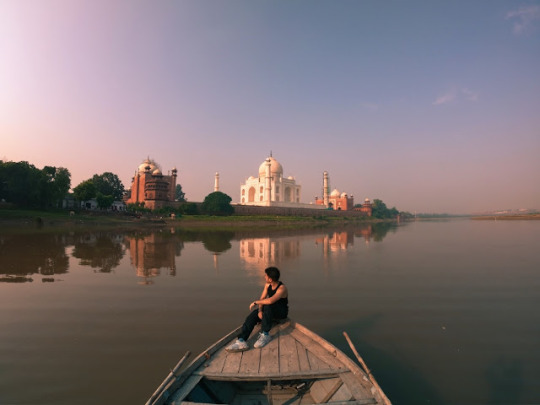
The Taj Mahal is in view as the sun is sinking, a boatman is navigating a wooden boat across the Yamuna, and the enormous white onion dome is reflected in the still waters. This is the scene that you typically see in travel guides or publications. Tourists are not permitted to ride a boat on the Yamuna, according to the law. Nevertheless, this does not imply that it is impossible; all you need to do is know who to ask and where to look. Who, after all, would want to sacrifice the Taj Mahal's best view for the sake of a few rules? Most hostels in and around Agra offer this tour but I found that the best way is to do it yourself from Dusshera ghat. (250 Rs p.p.)
The Trails of The Taj Nature Walk

This verdant parkland area is a short distance from the Taj Mahal via the East Gate Road and is crisscrossed by walking trails, picnic areas, and lookout points. If you're seeking for a little peace & quiet, you can anticipate it to be rather peaceful compared to the rest of Agra because the nature reserve is 70 acres in size and stretches from the road towards the banks of the Yamuna. While I was there, only two other couples were seen strolling the trail
Opening Hours: 7am – 6pm
Entry Fee: 100 Rs. for foreigners, 20 Rs for Indians.
Must Read: Must Visit Attractions around Agra
Agra Fort
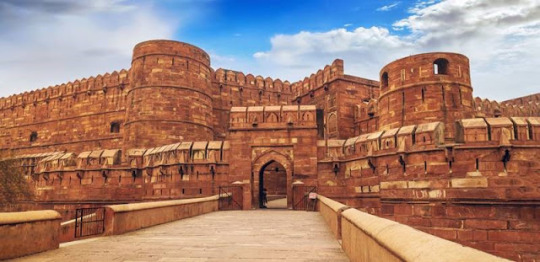
This remnant of the Mughal era made of red sandstone is Agra's most spectacular building except the Taj. Emperor Akbar started building it in 1565 along the Yamuna River's banks, and his grandson Shah Jahan later added white marble decorations. During his rule, what had been a vast military castle was changed into a palace.
The fort's size will be what most impresses you. The walls occasionally reach a height of 20 metres across its 2.5 kilometre diameter. The interior is just as spectacular as the exterior once you enter. The Shish Mahal (mirror palace), Khas Mahal, Diwan-e-khaas (hall of secret hearings), Moti Masjid (pearl mosque), and Nagina Masjid (gem/jewel mosque) are just a few of the magnificent buildings you can find here. To get the most out of your visit, my recommendation is to meander around the numerous buildings for a whole morning or afternoon.
Opening Hours: 7am – 6pm
Entry Fee: 100 Rs. for foreigners, 20 Rs for Indians
Chhatris by the Yamuna River- The Secret Taj Mahal Sunset Point

Possibly my favourite off-beat place to photograph the Taj Mahal from, this chhatri (dome shaped pavilion) by the Yamuna river is a must-visit monument in Agra. It is located just a short walk away from the East Gate entrance of the Taj, though getting there can be a bit tricky if you are alone and do not know where to go.
To reach this secret Taj Mahal sunset point, walk towards the direction of Dusshera Ghat on Dusshera Ghat Road from the East Gate entrance of the Taj. The perimeter wall of the Taj will be on your left as you make your way to the riverbank. Now, instead of going straight to the Ghat, take the first right (there is a small diversion so try not to miss it) to continue onto Dusshera Ghat Road.
#Where to Get the Best Views of the Taj Mahal in Agra#India#7 Best Taj Mahal View Point Locations in Agra#Where to Find the Best Views of the Taj Mahal in Agra#12 Best Taj Mahal Viewpoints in Agra#Taj Mahal View Point (Agra)#Best Views of the Taj Mahal
3 notes
·
View notes
Note
i wonder if tom and zendaya will ever confirm themselves that they dated before
I talked about this before. Unlikely but also not impossible.... If either one of them does an Oprah style interview with someone (doesn’t have to be Oprah but has to be reputable like Oprah) where attempt at truthfulness is expected , and juicy sound bites are wanted, and the question is asked about around when their rs started, I can see either one of them answering “we dated after shooting Hoco but kept it very secret because we really wanted to preserve our privacy and we thought that was the best way for us at the time”. Or something like that .
Actually I can see them throw in that “we dated before but in secret” bit because they probably thought it was an accomplishment to pull that (even though I don’t see any type of lie as a good means to accomplish something). Like I can see them low-key be proud like “that was our secret” (well, except for all the shippers who been knew 😬) but they did fool the general public though.
2 notes
·
View notes
Note
I am worried about him sustaining this schedule /
We don't know why he's doing these additional shows, but I suspect it's at least in part because of H's insular work/friend group.
I know there were a couple of anons yesterday who were between it being a bad/isolating thing and it being about trust/vulnerability, and I honestly think it's probably both. Like, it's definitely good that he has a small group he feels he can vulnerable with and he holds onto that in both work and life, but even if that small group has the purest, best intentions and makes every attempt to balance their competing interests 100% of the time (which I don't think his team does, not because they're bad people but because they're human), blurring the lines like that makes for some tricky situations. I think of it kind of like how a lot of non-NIMBY people become NIMBYs after they become homeowners - not because their policy preferences changed, necessarily, but because now their home is their biggest asset and protecting that value might outweigh other things (sorry if that was a weird reference, lol). But like, as an example, I'm sure Mitch and Sarah genuinely care for H and want only the best for him. But he's also their livelihood and it's impossible for them to advise him on things without that being at least in the back of their mind.
My point is just that even with good intentions, his team have certain incentives and they'll see things through the lens of those incentives. Like, circling back around - I felt like the additional shows were a response to the whole Leave America thing, and I felt like they were a misread. The Leave America thing was in part about America having way more shows than Europe, but also had wrapped up in it a lot of nuanced anger about the residency structure, the disparate tour experiences, expensive ticket prices, for a lot of people it was about the US music scene/culture, for some people it was about Holivia. But H's answer in the RS bit about Leave America reflected the oversimplified "I hadn't been to Europe in a long time" view and conveniently, seeing it through that lens also means adding a bunch of tour dates and (presumably) getting the proceeds from a lot more ticket sales. I hope that it's also the case that it's just something Harry wants to do, he definitely seemed like he enjoyed himself on the Europe leg in 2022, but it definitely seems to reflect a certain angle of interpretation that feels like it's maybe missing some outside, truly objective perspective.
All good points.
3 notes
·
View notes
Text

The Top 5 Adidas Running Shoes for Men

It is impossible to overstate the importance of a decent pair of running shoes in the ever-evolving realm of athletic performance and fitness. Whether you’re a seasoned marathon runner or just attempting to add some exercise to your daily routine. Adidas, a brand known for its quality and creativity. because This in-depth analysis will look at the top 5 Adidas running shoes for men that are all under $3999, offer good performance, and are reasonably priced.
Top 5 Adidas Running Shoes for Men Under RS 3999
Men’s Black Lace Up casual Shoes
Features:
Unmatched comfort with Boost midsole technology.
Primeknit upper for a snug, sock-like fit.
Suitable for various terrains.
Rs – 1199
Shop Now

Runesy M Running Shoes For Men
Features:
Exceptional stability and durability.
Energy rail reduces pronation.
Continental™ Rubber outsole for superior traction.
Rs – 2499
Shop Now

Street Ahead M Running Shoes For Men
Features:
Versatile with cushioning and support.
Boost midsole for comfort and response.
Torsion System provides stability.
Rs – 1625
Shop Now

Runesy M Running Shoes For Men
Features:
Perfect for off-road adventures.
Continental™ Rubber outsole ensures grip
Read More
For more trending shoes click on SHOP NO
#online shopping#shoes for men#shopping#shoes#shoes blog#adidas#adidas running shoes#adidas running shoes for men#shoes under 3999
0 notes
Text
What is the Fastest Missile in the World and How Much Does Speed Really Matter?

© Photo: Russian Defence Ministry
— Ilya Tsukanov | Sunday May 21st, 2023
Russia’s Kh-47M2 Kinzhal hypersonic missile made the news this week after destroying a Patriot radar station and five launchers in overnight strikes in Kiev on May 16. How did the Kinzhal get through? What other countries possess ultrafast missiles? Why is it that speed isn’t always everything? Check out our explainer to find out.
According to independent US media, the Patriots fired off as many as 32 interceptor missiles at the Kinzhals targeting them in a desperate attempt to intercept them. The Pentagon went into damage control, mindful that admitting the missile defense system’s weaknesses against Russian missiles would undermine global faith in the superiority of US weapons. Patriot missile maker Raytheon saw up to $10 billion shaved from its stock valuation over the news that its coveted weapons system had been hit.
US officials claimed the systems were “damaged,” but assured that they had not been destroyed. Ukraine’s military, meanwhile, claimed that it shot down six Kinzhals without losing any Patriots. The Russian military offered no comment.
But what else does Russia have in its missile arsenal?
What is the Fastest Russian Missile?
The Kinzhal is one of the speediest and most advanced missile systems in Russia's arsenal, but not the only one. The weapon is an air-launched hypersonic missile with a range of between 2,000 and 3,000 km, and a reported speed of Mach 10 (11,925km per hour) or even higher. The Patriot’s interceptors are significantly slower, capable of accelerating to Mach 2.8 (3,340 km/h) in the case of the PAC-1, and Mach 4.1 (5,000 km/h) in the case of its PAC-2 and PAC-3 variants.
The Kinzhal is not the fastest missile in Russia’s arsenal, with the strategic RS-28 Sarmat, and the submarine-launched Bulava missiles capable of accelerating to speeds of up to Mach 20 (25,500 km/h) and Mach 24 (28,600+ km/h), respectively. And while these are not hypersonic missiles, but ballistic weapons which travel into space and then release warheads that fall to Earth, they are capable of maneuvering like their hypersonic cousins (Bulavas at their boost stage, Sarmat warheads as they approach targets, or Avangard hypersonic glide vehicles fitted aboard Sarmats), theoretically making their interception impossible. Theoretically, because these weapons have never been tested in actual warfare, and, hopefully, never will, because their use would likely signal the start of a Third World War.
When it comes to missiles, speed isn’t everything, and the lower intercept speed wouldn’t be a problem if the Patriot were locking on to a traditional ballistic missile flying on a known trajectory. The problem is, missiles like the Kinzhal are capable of maneuvering in flight, making course corrections to make it more difficult to predict its trajectory and exact course.

Russia’s Sarmat ICBM Can Change Trajectory, Will Make Interception Hardly Possible in Coming Decades! "...today, they say that air defense does not exist for the Sarmat missile system, and it probably will not exist in the coming decades," Col. Gen. Sergei Karakaev, commander of Russia’s Strategic Missile Forces predicted. © Sputnik/Press Service of the Ministry of Defense of the Russian Federation/Go to the mediabank
What is the Number One Fastest Missile in the World?
Determining a missile’s maximum speed depends on definitions. As stated above, strategic intercontinental ballistic missiles typically have the highest speed characteristics, with the US ground-based LGM-30 Minuteman having a rating of Mach 23 (28,200 km/h), and the UGM-133 Trident II submarine-launched missile a top speed of Mach 24 in its terminal phase). The Chinese DF-41 ICBM is reportedly capable of flying up to Mach 25 (30,600 km/h), making it perhaps the fastest ballistic missile in the world today. As for hypersonics, the Avangard glide vehicle appears to enjoys the coveted top spot, with a maximum boost speed of up to Mach 27 (32,200 km) in near-space conditions (although this falls to an estimated Mach 15-20 by atmospheric drag on descent).
What is the BrahMos Missile, and Does Russia Use It?
The BrahMos ramjet supersonic cruise missile jointly developed by Russia and India carries the distinction of the fastest cruise missile in the world, with a top speed of Mach 3.5 (about 4,175 km/h) – fast enough to make short work of enemy vessels and ground-based targets and their air defenses. A new variant of the missile, the Brahmos 2, is under development, with an expected maximum speed of up to Mach 8 (9,800 km/h) thanks to innovative use of a scramjet air-breathing jet engine. The Brahmos 2 is a development of the 3M22 Zircon, a Russian scramjet-powered anti-ship cruise missile which entered into service in January.
Why are High Speed Missiles So Important to Russia’s Deterrence Doctrine?
Why does Russia seem to be at the top or near the top of most rankings when it comes to the capabilities of its hypersonic, ballistic, and cruise missiles? The answer is simple. Inheriting a massive head-start on advanced missile technology and the blueprints for the earliest hypersonic missiles from the USSR, which began work on them in the late 1960s, while missile tech was one of the areas where R&D investments was not totally curtailed in the 1990s.
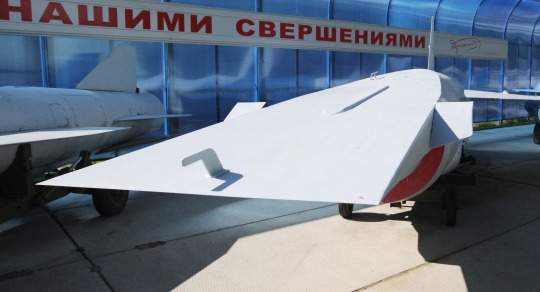
A Soviet hypersonic missile design displayed at an exhibition staged by the Raduga Design Bureau. File photo. © Sputnik/Sergey Mamontov//Go to the mediabank
In 2002, after the United States unceremoniously pulled out of the Anti-Ballistic Missile Treaty, President Vladimir Putin ordered work on existing projects to be accelerated, and for new ones to be laid down, amid concerns that the creation of a US strategic missile defense system could “neutralize and render obsolete our entire nuclear potential.” These efforts bore fruit, and in 2020, Putin said that for the first time in its modern history, Russia had come to possess “the most modern types of weapons, which are far superior in terms of their force, power, speed, and, very importantly, in terms of accuracy compared to all which existed before them and exist today.”
These upgrades to Russia’s missile capabilities couldn’t have been more timely, because at the same time that Washington scrapped the ABM Treaty, the Pentagon began working on "Prompt Global Strike" – an ambitious, but highly dangerous, initiative proposing mass precision-guided conventional missile strikes to decapitate adversaries’ political and military leadership and missile deterrents, thus stripping them of the ability to retaliate to aggression.

Prompt Global Strike as envisioned in a 2014 MIT presentation. © Photo: Subrata Ghoshroy, MIT
Basically, the possession of ultra-high speed missiles capable of maneuvering, evading missile defenses, and masking their destination provide Russia with a kind of missile "shield," allowing the country’s leadership to sleep soundly at night in the knowledge that surprise enemy aggression would be met with an inevitable and devastating response – thereby deterring any itchy trigger fingers at the Pentagon and forcing it to keep ideas like Prompt Global Strike on the drawing board.
0 notes
Text
On "Scientism" and Objective Beauty
Dear ___,
Thanks for sharing the links to these videos with me. I enjoyed watching them. I was not familiar with Roger Scruton; I expect to be learning more about him via my You Tube autoplay.
What was appealing to me about Prof. (? Sir) RS was the evident kindness and civility with which he employed his rhetorical skills, in addition to the level of those skills themselves. I see he is identified in Wikipedia’s index as a “conservative philosopher.” It’s good to see that such individuals exist; our noblest institutions created in the past deserve articulate defenders who can argue—in contemporary language—for their preservation in the face of those who would purge and radically reconstruct the culture.
I had some thoughts in regard to the first clip, the argument against “scientism.” RS’s position is reminiscent of (the late) Stephen Jay Gould’s concept that the arts, religion, and sciences each comprise their own “non-overlapping magisteria,” with their own associated axioms and rules of argumentation, their own sources of authority, not applicable beyond their own boundaries. But what is the nature of those boundaries, just what makes them so impermeable? Certainly it is true that works of art are created by human beings and, that human beings, having existence in a material universe, must be made up entirely of the elementary particles that comprise all matter. But the number of such particles, and the complexity of their arrangement, constituting even a single human being would make it impossible to use the scientific laws governing the behavior of elementary particles to deduce anything at all about the nature of art created by that human being. No sane person would carry reductionism to such a ridiculous extreme. But does this mean that the methods and knowledge from the sciences should never be brought to bear in considering issues involving art? Do considerations of the esthetic need to be mentally walled off from all other intellectual endeavors?
In pondering these questions, I’ve found the thinking of David Deutsch quite valuable; DD is a quantum physicist and polymath, who writes on a wide range of subjects, always searching for explanations to tie together the various aspects of reality. He invokes the concept of emergence as a way to understand the relation of highly complex systems to the simpler systems of which they are composed. One would speak of a system of high complexity (inorganic chemistry, poetry) as emergent from a lower-complexity system from which it derives its existence (particle physics, psychology of human emotions). Emergence arises when rules governing the behavior of the high-level system can be formulated simply and intelligibly without resorting to complicated explanations based on the underlying low-level system.
DD’s point, if I read him correctly, is that the boundaries between disciplines studying high- and low-level systems arise from what are essentially computational limitations, of both the human mind and artificial intelligence in its current state. The vast numbers of constituent low-level systems, and the complexity of the ways they are functionally integrated to produce the high-level system, make it impossible —practically impossible in most instances, I should say—for chains of deduction and inference to be carried across from low- to high level disciplines. But DD’s concept allows that there may be rare instances in which it is possible to make such deductions, and, in such rare instances the deductions should not be dismissed just because they are reductive. We should prize all valid explanations that we can find, regardless of their logical construction.
I’ve attached an excerpt from one of DD’s books which presents his ideas of emergence and the status of reductive explanation at greater length, and much more lucidly, than what I’ve just attempted.
In a different source, DD provides what I think is a splendid example of a (valid) reductive explanation of a topic in the arts, the nature of beauty, using Darwinian logic from modern biology. He begins by posing the question of why flowers are beautiful, and then devotes a chapter to its answer. Remarkably, that answer includes an argument that at least some things have beauty as part of their objective reality, that this beauty is independent of the subjective experience of the perceiving individuals or their cultures, or even of the human species. I’ve attached an excerpt from this, also.
Fred
At present, we have only approximations to a reductive ‘theory of everything’. These can already predict quite accurate laws of motion for individual subatomic particles. From these laws, present-day computers can calculate the motion of any isolated group of a few interacting particles in some detail, given their initial state. But even the smallest speck of matter visible to the naked eye contains trillions of atoms, each composed of many subatomic particles, and is continually interacting with the outside world; so it is quite infeasible to predict its behaviour particle by particle. By supplementing the exact laws of motion with various approximation schemes, we can predict some aspects of the gross behaviour of quite large objects – for instance, the temperature at which a given chemical compound will melt or boil. Much of basic chemistry has been reduced to physics in this way. But for higher-level sciences the reductionist programme is a matter of principle only. No one expects actually to deduce many principles of biology, psychology or politics from those of physics. The reason why higher-level subjects can be studied at all is that under special circumstances the stupendously complex behaviour of vast numbers of particles resolves itself into a measure of simplicity and comprehensibility. This is called emergence: high-level simplicity ‘emerges’ from low-level complexity. High-level phenomena about which there are comprehensible facts that are not simply deducible from lower-level theories are called emergent phenomena. For example, a wall might be strong because its builders feared that their enemies might try to force their way through it. This is a high-level explanation of the wall’s strength, not deducible from (though not incompatible with) the low-level explanation I gave above. ‘Builders’, ‘enemies’, ‘fear’ and ‘trying’ are all emergent phenomena. The purpose of high-level sciences is to enable us to understand emergent phenomena, of which the most important are, as we shall see, life, thought and computation. By the way, the opposite of reductionism, holism – the idea that the only legitimate explanations are in terms of higher-level systems - is an even greater error than reductionism. What do holists expect us to do? Cease our search for the molecular origin of diseases? Deny that human beings are made of subatomic particles? Where reductive explanations exist, they are just as desirable as any other explanations. Where whole sciences are reducible to lower-level sciences, it is just as incumbent upon us as scientists to find those reductions as it is to discover any other knowledge. A reductionist thinks that science is about analysing things into components. An instrumentalist thinks that it is about predicting things. To either of them, the existence of high-level sciences is merely a matter of convenience. Complexity prevents us from using fundamental physics to make high-level predictions, so instead we guess what those predictions would be if we could make them – emergence gives us a chance of doing that successfully – and supposedly that is what the higher-level sciences are about. Thus to reductionists and instrumentalists, who disregard both the real structure and the real purpose of scientific knowledge, the base of the predictive hierarchy of physics is by definition the ‘theory of everything’. But to everyone else scientific knowledge consists of explanations, and the structure of scientific explanation does not reflect the reductionist hierarchy. There are explanations at every level of the hierarchy. Many of them are autonomous, referring only to concepts at that particular level (for instance, ‘the bear ate the honey because it was hungry’). Many involve deductions in the opposite direction to that of reductive explanation. That is, they explain things not by analysing them into smaller, simpler things but by regarding them as components of larger, more complex things – about which we nevertheless have explanatory theories.
Deutsch, David. The Fabric of Reality (pp. 20-22). Penguin Publishing Group. Kindle Edition.
Occasionally it happens by chance that the parochial criteria of attractiveness that evolved within a species produce something that looks beautiful to us: the peacock’s tail is an example. But that is a rare anomaly: in the overwhelming majority of species, we do not share any of their criteria for finding something attractive. Yet with flowers--most flowers--we do. Sometimes a leaf can be beautiful; even a puddle of water can. But, again, only by rare chance. With flowers it is reliable.
It is another regularity in nature. What is the explanation? Why are flowers beautiful?
Given the prevailing assumptions in the scientific community—which are still rather empiricist and reductionist--it may seem plausible that flowers are not objectively beautiful, and that their attractiveness is merely a cultural phenomenon. But I think that that fails closer inspection. We find flowers beautiful that we have never seen before, and which have not been known to our culture before--and quite reliably, for most humans in most cultures. The same is not true of the roots of plants, or the leaves. Why only the flowers?
One unusual aspect of the flower-insect co-evolution is that it involved the creation of a complex code, or language, for signalling information between species. It had to be complex because the genes were facing a difficult communication problem. The code had to be, on the one hand, easily recognizable by the right insects, and, on the other, difficult to forge by other species of flower--for if other species could cause their pollen to be spread by the same insects without having to manufacture nectar for them, which requires energy, they would have a selective advantage. So the criterion that was evolving in the insects had to be discriminating enough to pick the right flowers and not crude imitations; and the flower’s design had to be such that no design that other flower species could easily evolve could be mistaken for it. Thus both the criterion and the means of meeting it had to be hard to vary. When genes are facing a similar problem within a species, notably in the co-evolution of criteria and characteristics for choosing mates, they already have a large amount of shared genetic knowledge to draw on. For instance, even before any such co-evolution begins, the genome may already contain adaptations for recognizing fellow members of the species, and for detecting various attributes of them. Moreover, the attributes that a mate is searching for may initially be objectively useful ones--such as neck length in a giraffe. One theory of the evolution of giraffe necks is that it began as an adaptation for feeding, but then continued through sexual selection. However, there is no such shared knowledge to build on across the gap between distant species. They are starting from scratch.
And therefore my guess is that the easiest way to signal across such a gap with hard-to-forge patterns designed to be recognized by hard- to emulate pattern-matching algorithms is to use objective standards of beauty. So flowers have to create objective beauty, and insects have to recognize objective beauty. Consequently the only species that are attracted by flowers are the insect species that co-evolved to do so--and humans.
If true, this means that Dawkins’ daughter was partly right about the flowers after all. They are there to make the world pretty; or, at least, prettiness is no accidental side effect but is what they specifically evolved to have. Not because anything intended the world to be pretty, but because the best-replicating genes depend on embodying objective prettiness to get themselves replicated. The case of honey, for instance, is very different. The reason that honey--which is sugar water --is easy for flowers and bees to make, and why its taste is attractive to humans and insects alike, is that we do all have a shared genetic heritage going back to our common ancestor and before, which includes biochemical knowledge about many uses of sugar, and the means to recognize it.
Could it be that what humans find attractive in flowers--or in art--is indeed objective, but it is not objective beauty? Perhaps it is something more mundane--something like a liking for bright colours, strong contrasts, symmetrical shapes. Humans seem to have an inborn liking for symmetry. It is thought to be a factor in sexual attractiveness, and it may also be useful in helping us to classify things and to organize our environment physically and conceptually. So a side effect of these inborn preferences might be a liking for flowers, which happen to be colourful and symmetrical. However, some flowers are white (at least to us--they may have colours that we cannot see and insects can), but we still find their shapes beautiful. All flowers do contrast with their background in some sense--that is a precondition for being used for signalling--but a spider in the bath contrasts with its background even more, and there is no widespread consensus that such a sight is beautiful. As for symmetry: again, spiders are quite symmetrical, while some flowers, such as orchids, are very unsymmetrical, yet we do not find them any less attractive for that. So I do not think that symmetry, colour and contrast are all that we are seeing in flowers when we imagine that we are seeing beauty.
A sort of mirror image of that objection is that there are other things in nature that we also find beautiful--things that are not results of either human creativity or co-evolution across a gap: the night sky; waterfalls; sunsets. So why not flowers too? But the cases are not alike. Those things may be attractive to look at, but they have no appearance of design. They are analogous not to Paley’s watch, but to the sun as a timekeeper. One cannot explain why the watch is as it is without referring to timekeeping, because it would be useless for timekeeping if it had been made slightly differently. But, as I mentioned, the sun would still be useful for keeping time even if the solar system were altered. Similarly, Paley might have found a stone that looked attractive. He might well have taken it home to use as an ornamental paperweight. But he would not have sat down to write a monograph about how changing any detail of the stone would have made it incapable of serving that function, because that would not have been so. The same is true of the night sky, waterfalls and almost all other natural phenomena. But flowers do have the appearance of design for beauty: if they looked like leaves, or roots, they would lose their universal appeal. Displace even one petal, and there would be diminishment.
We know what the watch was designed for, but we do not know what beauty is. We are in a similar position to an archaeologist who finds inscriptions in an unknown language in an ancient tomb: they look like writing and not just meaningless marks on the walls. Conceivably this is mistaken, but they look as though they were inscribed there for a purpose. Flowers are like that: they have the appearance of having been evolved for a purpose which we call ‘beauty’, which we can (imperfectly) recognize, but whose nature is poorly understood.
In the light of these arguments I can see only one explanation for the phenomenon of flowers being attractive to humans, and for the various other fragments of evidence I have mentioned. It is that the attribute we call beauty is of two kinds. One is a parochial kind of attractiveness local to a species, to a culture or to an individual. The other is unrelated to any of those: it is universal, and as objective as the laws of physics. Creating either kind of beauty requires knowledge; but the second kind requires knowledge with universal reach. It reaches all the way from the flower genome, with its problem of competitive pollination, to human minds which appreciate the resulting flowers as art. Not great art--human artists are far better, as is to be expected. But with the hard-to-fake appearance of design for beauty.
Now, why do humans appreciate objective beauty, if there has been no equivalent of that co-evolution in our past? At one level the answer is simply that we are universal explainers and can create knowledge about anything. Bur still, why did we want to create aesthetic knowledge in particular? It is because we did face the same problem as the flowers and the insects. Signalling across the gap between two humans is analogous to signalling across the gap between two entire species. A human being, in terms of knowledge content and creative individuality, is like a species. All the individuals of any other species have virtually the same programming in their genes and use virtually the same criteria for acting and being attracted. Humans are quite unlike that: the amount of information in a human mind is more than in the genome of any species, and overwhelmingly more than the genetic information unique to one person. So human artists are trying to signal across the same scale of gap between humans as the flowers and insects are between species. They can use some species-specific criteria; but they can also reach towards objective beauty. Exactly the same is true of all our other knowledge: we can communicate with other people by sending predetermined messages determined by our genes or culture, or we can invent something new. Bur in the latter case, to have any chance of communicating, we had better strive to rise above parochialism and seek universal truths. This may be the proximate reason that humans ever began to do so.
Deutsch, D: The Beginning of Infinity, p. 361
0 notes
Text
Bully me you, I exemplified archetypal scapegoat
Even as an old curmudgeon, aye pucker
and raspily suction, albeit toothless mouth
drawing reminiscent guffaws affecting
(think feeble attempt
impersonating plumber plunging -
unclogging backed up toilet),
flushed with satisfaction,
now snakes into following non sequitur,
whereby then upperclassman,
whose name Scott Lambert
I suddenly remembered
modest fellow one year my senior
- donned tee shirt
“please support your local bummer”
yes folks back in the day,
one long haired pencil neck geek
palled around with another
hirsute nerd - Roger Kummerer,
(who both of us graduated Methacton
High School class of 1977),
and yours truly readily
admitting, alluding, and attesting
without shadow of doubt
representing the dumber
than rocks of said rolling stones
foo fighting beastie boys
allied with Smokey and the bandits,
the latter donning outsize
particolored grey pachyderm trunks,
Tuscaloosa so far away;
especially as Mummer doth strut
on unseasonably warm New Year's Day
sporting polar bear look-alike
gabardine garb getup trumpeting,
merrily squeezing Charmin
rubbing her/his tuchus
excellently exhibiting posterior
as chief motormouth sound
of combo motorboat hummer.
Mein kampf elapsed distressfully
even now scores of decades later
ah..., the joys of amazingly aging gracefully
recalling happily never
being beat into pulp daily courtesy
imagine dragons saving me hide
'though dimming sense and sensibility
before (appearing gratefully dead)
lifeless body dumped into gully,
nevertheless all the while fully
maintaining consciousness, and forcefully
summoning forth latent powers gleefully
choking living daylights masterfully
delivering just desserts upon Tom Viglione,
whose plaintive laments truthfully
resonate as blessed music
to ears unaccustomed hearing pitifully
sounding long overdue comeuppance
forever disbelieving wrongfully
perpetrated intimidating injustice
witnessed courtesy mine doppelgänger,
who wanted to strangle
the m****r f****rs yearningly
fueling an ordinarily meek lad
only in his dreams, he envisions zestfully.
Pugnacious thuggish hooligans... although
decades long since elapsed,
whereby muscle bound hoodlums
jockeyed to rain
one after another verbal Hawaiian punch,
and bandied fist viz physical blow
threatening introverted diminutive boy
who, no surprise did eventually,
albeit (shamefacedly, sneakingly,
and stuntedly) didst grow
(as an aside resembled anorexic
Kris Kringle ho... ho... ho...),
which long sleeved Santa suit
rendered invisible liver spots;
said epidermal splotches black and indigo
wracked (in my pinion), impacted, and affected...,
this punster, he haint Joe
King, but upholds true value
nudging anonymous reader to chuckle
thru contrived written words y'know
good humor less or mo'
yours truly aspires toward po'
whit tree linkedin with infusing,
feebly, lamely, and quirkily
(no matter recognizing ex post facto)
impossible mission reporting punks to principal,
hence describing, envisioning, forsaking passivity
as defensive modus operandi status quo
finally freeing mine unsung
inner foreigner juke box hero.
0 notes
Photo



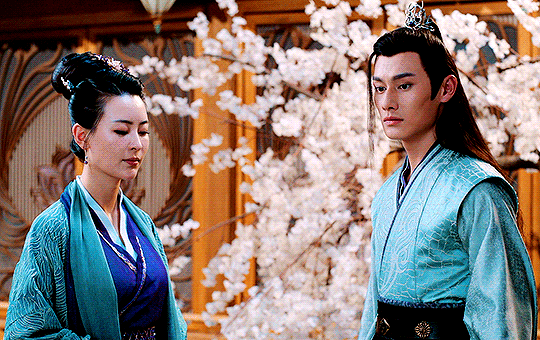
thirty-one days of jiujiu(ly) — day twenty-one
+ with bonus a-niang !
#the waterish blue robes my beloveds <3#theuntamededit#mdzsedit#dailyuntamed#cqledit#the untamed#mdzs#jiang cheng#yu ziyuan#wang zhuocheng#zhang jingtong#cql#fdstuff#fragifs#jiujiuly#rs: attempt the impossible#i can fix her !!!! hello!!#tv
1K notes
·
View notes
Text
Let’s Talk About Norman
I’m going to start off by telling you all something you probably already know: Norman is abusive. I try not to use super strong language on this blog because calling someone abusive / toxic is a pretty big deal, but Norman is an abuser, full stop. Aside from the obvious physical violence though, there’s a lot of emotional trauma he causes Ruby through his actions— this post is mostly going to be talking about Norman’s emotional abuse and how it affects Ruby’s psyche and actions throughout the arc instead of just “oh he punched his son down some stairs” because I think it goes way deeper than that. With that out of the way, the rest of the post is below the cut!
PHYSICAL VIOLENCE
I can’t talk about Ruby and Norman without mentioning this— it’s the most clear cut evidence of his abuse on-panel. He punches his son down the stairs, engages in a high stakes fight with him, and puts him in mortal danger (which Ruby has to save himself from). What I’m concerned with isn’t the actual incidence of violence itself, but rather the emotional baggage that comes with it.
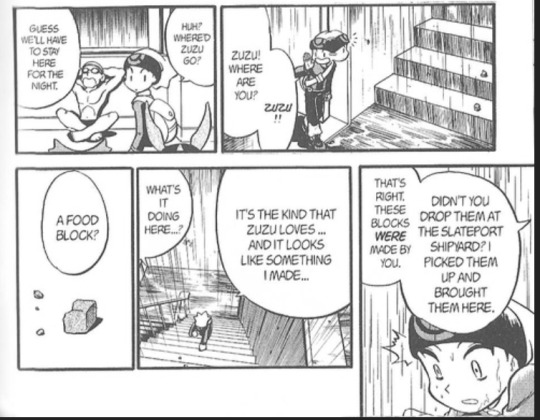
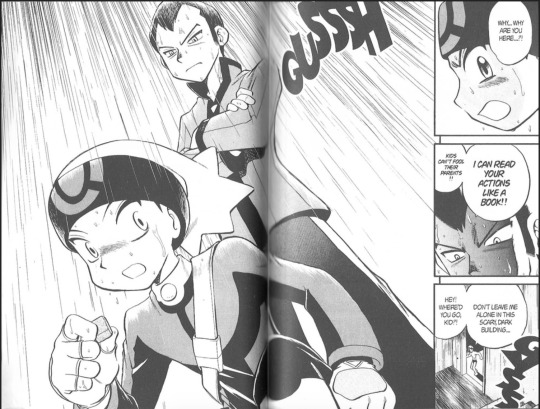

The interesting thing about the Big Fight scene to me is that Norman instigates the conflict. Norman lures Ruby into a “dark and scary building” in the rain and away from others, appears behind him, threatens him, and throws him against a wall. The only thing Ruby had done in that moment is ask his dad how / why he had found him— Norman was the instigator of violence. It is Ruby’s reaction to this immediately violent start that segues into the next Big Thing about their relationship.
ENVIRONMENT OF FEAR
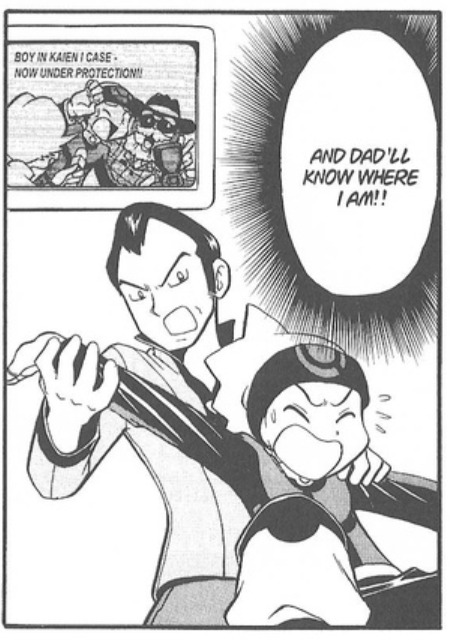

It is obvious from the minute Norman appears on panel that he is intimidating. Multiple characters throughout the arc mention that they are scared of / intimidated by him, but none are more obvious than Ruby. In fact until we reach the scene at the Weather Institute, Norman hasn’t been shown in a positive light at all from Ruby’s perspective. Ruby continuously mentions fear about his father: he imagines his father grabbing him, looking angrily at him, and generally seems to be afraid of him. Ruby expresses worry and concern about the consequences of his father’s anger— and that’s ALL he thinks about. Ruby mentions explicitly that he has seen “Norman’s Dark Side” and tries to hide as soon as he appears. He even shivers at the mere mention of Norman. Ruby’s entire motivation is his fear of his dad, which is bad, obviously.
Every thought about Norman that Ruby has up until the Weather Institute about Norman express fear and stress Norman’s emotional distance. Whether or not Ruby and Norman love each other is not of importance here, what is important is that Ruby has constant worry and anxiety about how Norman will react. His entire motivation at the beginning of the arc is centered around doing things behind Norman’s back and giving him definitive proof of Ruby’s accomplishments— Ruby is so nervous around Norman that he considers communicating to be a risk. This is typical abuse victim behavior and it continues through the arcs. Living under the constant threat of (often violent) punishment has taught Ruby that disagreements and communication in general are dangerous and can spiral into violence very, very quickly— he displays this same fear time and time again.
Quick Aside:
As everyone here probably knows, the main conflict in the oras arc is centered around Ruby’s unwillingness to tell Sapphire what is going on for fear of how she will react. Ruby’s hiding of his memory of their confession in the Emerald arc is the same— Ruby refuses to communicate because he is afraid of how Sapphire will react. His main emotional flaw is the fact that he is driven by fear; Norman has shown him there are consequences to communication and Ruby carries this lesson throughout his entire life. He is a victim of abuse and this hampers his ability to communicate and be emotionally vulnerable. He is so caught up in the idea of consequences that he is more than willing to lie or omit the truth to avoid the consequences of talking to people about stressful topics. This is not to say that Ruby’s actions are excusable— he’s still a dick with communication issues, but whether or not Kusaka intended it, Norman’s abuse and its consequences define Ruby’s emotional arc.
ANGER ISSUES
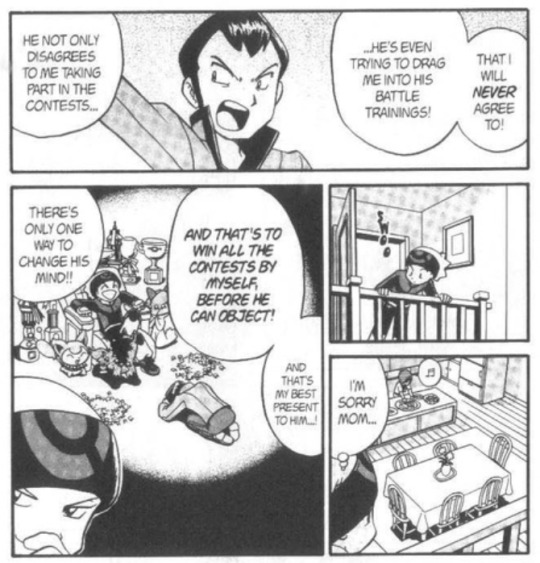
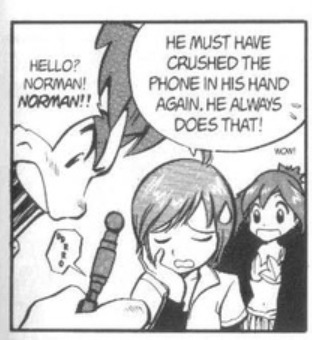
I can’t really talk about the environment of fear that Norman created without talking about his anger issues. He crushes a phone, shoves people out of the way, knocks multiple Pokemon out at once, and otherwise acts aggressively in various situations throughout the arc without any real Reason. As if these hints weren’t enough, we actually get confirmation through Ruby’s mother that Norman “does this often”— and judging by Birch’s reaction, these displays of destructive anger aren’t normal in in-universe. Whether or not there is a violent / strict parenting style within the universe doesn’t matter, because Norman is shown to be uncharacteristically aggressive in comparison to other adults in the series. Judging by Ruby’s reaction at the Weather Institute, he implies that his type of violence towards him isn’t uncommon; he seems almost resigned to it.
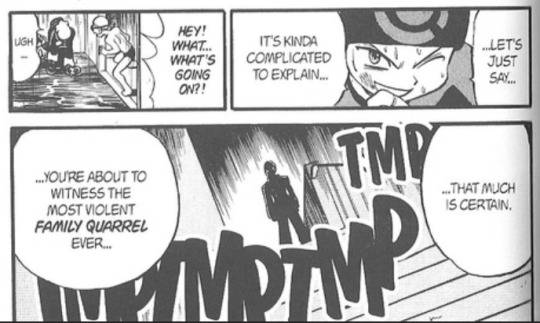
To wrap up this section: Norman’s aggressiveness is atypical even in-universe, he is shown to be unable and unwilling to curb his violent anger, and this creates an environment of fear among his family that permanently impacts Ruby’s ability to communicate effectively with others.
PART 2
DISCLAIMER: This is where things get… dicey. Everything I’ve mentioned previously is rooted in the actual drawings and actions of the characters or overarching themes / problems. This next part however focuses on dialogue. It is almost impossible to truly understand the tone of each line without being a fluent Japanese speaker (which I am not) so instead I’m going to use Viz and CY to the best of my ability for this section. I’m not going to extrapolate this to Kusaka’s intentions, since without the original work that’s nearly impossible, but I can at least talk about the way these come off in English.
EMOTIONAL ABUSE
Admittedly, Viz is the worst about this. They constantly hype Norman up and excuse his behavior, outright censoring some of the physical and emotional abuse. Viz absolutely mangling the tone of RS, however, is a post for another time.
Because Norman actually speaks to Ruby at length a grand total of twice times in the RS arc, we can break down his actions into these two instances: the first is at the weather institute and the second is as he’s dying.
Rather than go based on overall theme, this scene is best done line by line (this is using the CY version due to limited censorship compared to Viz).
Scene 1: Volume 17, Chapters 208-210
(Norman is dangling Ruby off the roof of a building by his collar. There are sharp rocks at the bottom)
Ruby: Re… release me…!
Norman: Insolent brat!! Is that how you talk to your father?!
To start, Norman uses tone policing and deflection. He focuses on the fact that Ruby is “talking back” to him and making demands of his father, which doesn’t acknowledge Ruby’s request or the fact that Ruby is being dangling over the roof of a building. Also note that this is the first time the words are bolded and that they stay this way throughout the fight— Norman verbally escalates the fight. Norman is abusing his position of power over Ruby in order to excuse his actions and pass the blame back to his son.
Ruby: I don’t care how furious you are with me… I’m ready for it!
(Norman decks Ruby down a flight of stairs)
Norman: Why did you run away from home?!
Note once again that Norman is implied to start raising his voice first even when Ruby isn’t. There’s another deflection here: Norman changes the subject rather than actively respond to anything Ruby says.
Norman: Well? Say something! You’d better voice your complaints right now!!
(Ruby has a conversation with the Swimmer, who advises him to apologize to avoid his father’s rage and “just go home” which… fuck you Swimmer Jack. I’m skipping that part of the dialogue bc it isn’t that important).
(While Ruby is debating what to do, Norman’s Slaking lifts the stairs that Ruby is on and tries to fling him into next Tuesday).
Ruby is physically prevented from escaping by being dangled above Norman. I shouldn’t have to tell why physically preventing someone from leaving an argument is a bad thing.
(Ruby decides to fight Norman)
Note that Norman is physically and emotionally forcing Ruby into two possible options: Fight or be obedient. He is preventing Ruby from running and deflecting Ruby’s attempts to explain himself. He then shifts the blame to Ruby *again*, attacking Ruby and his pokemon with full force and implying it was Ruby who instigated the conflict in the first place.
Norman: … so you wish to fight me? … Iron Tail and Hyper Beam… I was the one who taught you those attacks. There’s nothing about your attacks and strategies I don’t know about. You’re just wasting your time! Give up!
Here, Norman does two things: he stresses Ruby’s dependence on him and his power over Ruby. It’s a typical “your success is dependent on me” and a “there is no option except obedience” rhetoric, and is likewise typical of abusers. Norman is stressing the things Norman has gifted to Ruby (battling knowledge) and using whatever he can to force Ruby to do what he wants— he’s exerting his control.
(Ruby turns the tide of the battle, so Norman likewise switches tactics by attacking Ruby himself and attempting to hit him with a staircase. Ruby falls down the stairs and is dangling over a pit of spikes when Norman stands on the edge, blocking Ruby’s only escape route).
Norman: Now will you come quietly? Stop being so stubborn
Not only is Norman forcing his son to choose between obedience and Literal Death, he also shifts the blame again. He excuses his own actions by claiming it is Ruby’s stubbornness that forced him into this position. He deflects the whole “putting my 11 year old in harm’s way” by claiming Ruby’s own resistance to Norman’s violence is the trigger for the violence itself. It doesn’t make sense, but it’s victim-blaming nonetheless and sadly, it works
(Flashback time: Norman admits he was going to give Ruby permission to participate in contests and gets emo about it. They fall, but Norman catches Ruby. This doesn’t matter though, because they both end up falling and Ruby uses his running shoes to save them both).
Ruby: (thinking) Ru- running shoes… my birthday present from dad… saved both… our lives
Ruby displays pretty typical abuse victim behavior here, focusing not on Norman’s 3 threats to literally kill him but instead on the One Good Thing Norman did. He doesn’t mention that it was Ruby himself who saved them both or that Norman was the one who put them in danger in the first place— he’s in total denial about the severity of everything that happened.
(At this point, Norman looms above Ruby with an angry expression and a raised pokeball. Bystanders panic because it appears that Norman is going to attack Ruby who, by the way, is unconscious on the ground, but Norman gets a surprise call from Winona and turns away after realizing that Winona can see him).
“I only stopped attacking my son when I realized people were watching”… alright fuck off then Norman
Norman: HEY!! Idiot son! You disobeyed your parents, then you ran away from home. I’ve had enough! Just do what you want! In return, you’d better accomplish your goals!! A man should complete what he has set out to do… … before he can return home!!
Hoo boy. Norman never apologizes, deflects all the blame onto Ruby, insults him twice, and then tries to save face with Winona and the people around him by giving Ruby permission to do contests— which he was apparently planning to do all along. He emphasizes the things Ruby did in response to Norman’s actions (Ruby ran away from home because he knew his dad would be unsupportive and gets violent during disagreements, so in essence Norman is to blame for backing him into a corner). Norman twists the narrative in order to make Ruby the instigator in every case, justifying Norman’s responses as reactions to Ruby’s problematic behavior
Swimmer Jack: Isn’t that a wonderful father?
Ruby: Thank you… father.
Ok first of all Jack is a dumbass, so jot that down. Second of all, while it’s unintentional, Ruby is being gaslit to hell and back. It is only after Norman’s omission of all the abusive behavior and bystanders’ affirmation of Norman’s love that Ruby starts to think positively towards his father. The threat Ruby used to think was so large has been downplayed and outright denied by the people around him, so Ruby’s prior fear of Norman diminishes. Ruby’s fear of Norman and the violence Norman took against him is denied, downplayed, and ignored, so Ruby begins to doubt his own animosity towards his father. Thanks Swimmer Jack you unintentionally gaslit an 11 year old.
SCENE 2: (this one is much shorter, thank god)
(Norman, while he is dying, explains the whole deal with how he was ordered to search for Rayquaza yada yada. Throughout the exchange, Ruby gets increasingly upset).
Ruby: (thinking) barred from the test and forced to search for Rayquaza… It must be some kind of punishment! What could Dad have done to warrant such… why was he made responsible… ?!
Ruby: … … but… come to think of it, dad is not someone who makes mistakes easily… something’s not right!
Slight aside, Ruby has been so convinced of his father’s power by others that he is unwilling to even CONSIDER that his dad fucked up, which… wow!
Ruby: That day… Dad must have taken the rap for someone else… and… (flashbacks to Salamence Incident) that person… was….
Ruby: (out loud) … me?! That person who set Rayquaza free… was it me…?!
Norman: Yes.
And then he dies!
(Technically he says “oh I did all that out of love” (paraphrased) and then dies but it’s just a continuation of the previous thing).
Norman, before dying, does not say “I’m proud of you” or “I’m sorry for everything” or anything remotely comforting, instead he says “hey Ruby, you’re responsible for my death and all your childhood trauma alongside your friend’s. Peace.” (this is paraphrased).
Even on his actual deathbed, Norman places the blame on Ruby for Norman’s own actions. He makes Ruby feel guilty for Norman leaving, Norman hiding information from him, and Ruby’s tumultuous childhood.
CONCLUSION
None of this is to say that Norman doesn’t love Ruby or that Ruby doesn’t love him back— I’m fairly positive the two of them love each other dearly and want the best for each other. However, Norman is a child abuser who reacts violently, instigates violence, and then turns around and denies said violence. He creates a culture of fear among his family, gives Ruby some serious communication issues, and the narrative takes his side. Norman is a child abuser in canon and has a very VERY profound effect on Ruby which has emotional ramifications throughout Ruby’s entire character arc all the way until oras.
TLDR: Normans sucks man
310 notes
·
View notes
Note
Gerrymandering.
Gerrymandering BAD
But also it's more complex than you think. Like we should absolutely do some of those laws to make it less obviously bad, but the problem with gerrymandering is that there are several potential end possibilities in getting rid of it and they all have major different effects.
Let's say there is a state with 4 congress seats and a 75R to 25D split (Utah, but a bit simplified). How do we determine what is fair?
There is the statistically representative district, which is the idea that every district is representative of the whole as much as possible. So every district is cut up so they have a 75/25 split. In this case, it will always mean R wins in every case, us progressive Utahns never get anything. But it also means that in a near 50/50 state every race is competitive.
Another model attempts to cut up districts such that the result will be a similar split in reps to the population. In Utah, that would be 1 dem, 3 rs. But this basically ruins the very concept of an election by rigging it in the first place, towards what some people might call a pre determined "fair" outcome. Elections become non competitive.
We could do it by obvious geographic boundaries, but that's a crap shoot on who it favors politically and who it screws over. It is pretty much certain that it won't be representative in the end no matter what, but at least it is based in something real.
So gerrymandering bad, but maybe the entire concept of Congressional districts is stupid as fuck and needs to be done away with for something that isn't inherently unfair trash.
I like the idea of congressmen being chosen state wide instead of by district via ranked vote, but that becomes a heavy cognitive burden for voters in large states with many people and congressmen.
So I don't have the answer except congressional districts as they exist are inherently shit. I presume other countries have tried other things. Maybe we can check that out.
BUT now let's talk about the US senate. It's not gerrymandered in the classic sense, but the way it is put together is insane and completely unfair. I calculated it once, people from Wyoming have about seventy times as much voting power for the senate as people from California over what is, arguably, the single most important institution in our country. Controlling the senate is more powerful than controlling the presidency. And, effectively, a Californian gets 1 vote for it and a Wyoming resident gets 70. It is incredible bullshit that is literally ruining our country. If you thought the electoral college was bad imagine that jacked up to 11.
We can overcome the inherent system bias in selecting the president. It is impossible to overcome the inherent system bias in electing the senate. It is only because the US citizenry overwhelmingly favors the left that a deadlock tie is even possible. It might be possible to get one or two more seats for a slight majority that allows democrats to get something done.
The fact that the republicans aren't locking down the senate every single election despite their enormous technical advantage shows you how incompetent and hated they are by the average American. And yet they have the fucking audacity to claim that giving DC citizens senators is a democrat power grab and have instead purposed that the DC population be absorbed into a different senate group in order to ensure the overwhelming republican advantage remains in place. And they still can't win, so they try to rig it even further with voter suppression laws.
The worst voter suppression in the country doesn't happen in gerrymandered congress districts or at polling places. It's the very structure of the us senate.
5 notes
·
View notes
Text
star trek being like “humans could not pronounce spock’s full vulcan name” and then painting themselves into the corner of not being able to have anyone use it onscreen because the characters are being played by human actors is hilarious to me. my personal opinion is that it should have a sound humans literally cannot pronounce because of our differing anatomy - people sharper than me have pointed out that someone fluent in hebrew could probably get pretty close to the vulcan family names we have transliterations of... and seriously, s’chn t’gai seems pronounceable. maybe go back to xtmprszntwlfd?

I would love to see star trek attempt to fuck up a voice in aftereffects enough to fill in one of the gray boxes on the international phonetic alphabet chart. this chart (abridged, full one here: https://upload.wikimedia.org/wikipedia/commons/8/8f/IPA_chart_2020.svg) represents distinct sounds in human spoken languages, but there are sounds, represented by the grey squares, which do not appear in any known languages because they’re judged impossible for a human to create.
this chart is read with the location the sound is produced on the top, and the method in which it is created on the side. for instance, glottal stops/glottal plosives/ʔ are produced down in the throat, like “uh-oh” in an american accent. a trill, like a plosive, refers to the way in which a sound is formed, rather than the location in the mouth it’s made. rolled rs are trills. so a human cannot make a glottal trill, at least not a human with standard anatomy, but star trek aliens hypothetically could have names that are anatomically impossible to pronounce for humans, no matter what accent they have.
#armchair linguistics#star trek#any people with more knowledge of linguistics than me PLEASE issue corrections i will edit this post if it needs any
30 notes
·
View notes
Text
How to Study For: Uni Entrance Exams
14 JUL 2020
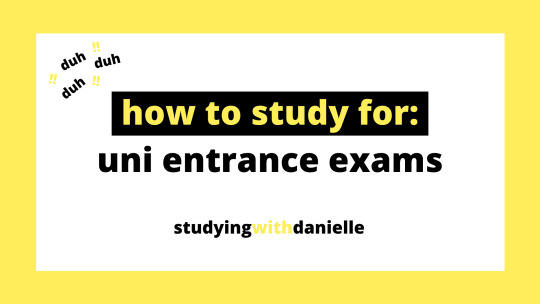
Hey guys! I’m currently studying for the TSA and I thought it would be helpful for me to consolidate my process so I can look back on it. Then I remembered that I have a studyblr (woop woop 🎉!) and that I can possibly help others by posting it on here.
NOTE: This is a strategy for exams consisting of multiple choice or short answer questions. If you’d like me to cover essay question prep, just let me know 🥰 !
Btw, I’m a conceptual learner that likes formulas so if this sounds like a rocket launch countdown, I deeply apologise ?.
What You’ll Need:
Internet - I mean, what don’t we use it for these days?
Practise papers
Practise questions
Phase 1 - Preparation
Step 1: Don’t panic
Okay you can panic a little, especially if you’ve left it late but not all hope is lost!
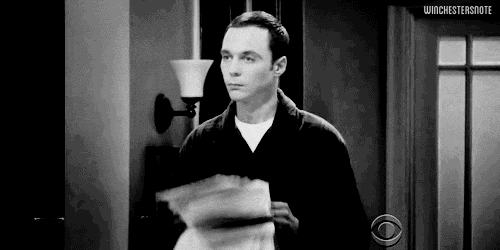
Yes, I know the ‘duh, duh, duh!!!’ didn’t help but panicking will only make you feel overwhelmed and will make the exam seem impossible. Here’s what you should do instead:
Step 2: Find out what the university actually wants
Why do they have an entrance exam anyway?
Especially in the UK, most universities don’t have an entrance exam so if they do, there’s a reason and you’re going to be Sherlock Holmes and find out why that is. Whilst it may seem like they’re trying to traumatise you, I don’t think they particularly enjoy marking a zillion papers 🤧.
What do they expect?
For most university courses, there are a grade requirements and knowing what those are is really helpful for setting your own expectations. If your course (likes mine) doesn’t require maths and there are maths problems on the exam, they won’t be at A-level, IB HL or AP standard.
What score should I be aiming for?
This links to the previous question but finding admissions stats for your subject will help you determine a mark that you’re aiming for. Many of these tests are not designed for really high marks so releasing that expectation early will save you a great deal of stress.
What skills are they testing?
For some entrance exams, the university will list out the skills they’re testing in their entrance exam. Practising these skills broadly will help you to develop them. For example, if they’re testing translation in a language entrance exam, reading in the target language and understanding it will be good practise because you’ll be able to convey ideas from another language if you understand them.
Step 3: Master your strategy
The worst thing that could happen in an exam is that you don’t know what to do or what to write. The best way to tackle that? Having a strategy. Sometimes just having something to do in an exam even if you don’t actually know what you’re doing gives your brain some time to stop freaking out and start problem-solving. To master your strategy, you need to:
Find out the question types
For example, the TSA is split into 2 sections (I have to do both 😭), one multiple-choice paper and one 30 minute essay. I know there are about 9-10 different types of questions targeting 2 skills: critical thinking and problem-solving. By doing this, I can work towards perfecting each question type and in theory will be able to do the whole of the first paper.
Figure out the timings
You can do this in minutes per mark or if there’s an advised amount of time you should spend on a particular type of question, take a note of this.
Figure out your process for each question type
Usually at the beginning of a book full of practise questions, there will be a description as to how best to approach each question. If there isn’t or you don’t have access to one, try looking up strategies on the wonder that is the Internet. If you’re still not sure, attempt questions with commentary answers so that id you get them wrong, you can create a strategy of your own using the tips you’ve gathered from there.
Practise, practise practice. Oh, and did I say practise?
When practising questions:
Make sure to practise a block of questions that are all the same type. This will allow you to learn how to identify the question type quicker and also gives you a sign to stop so you don’t spend all day working on these questions because you’re stressed 😪.
1. Attempt the question
2. Mark the question
3. If you got it wrong, try and figure out why yourself - write this in a different colour.
4. Check the markscheme or talk-through (if there is one) and add in anything you may have missed or anything that could be helpful for the next question in another colour. Now you’ve differentiated between what you could figure out and what you couldn’t.
5. Attempt the next question
*This may seem tedious because why would you not mark all the questions at the end? Doing it this way ensures you approach each question with a better idea of what to do and allows you to pick up on nuances that you may not have otherwise realised. Also, you don’t want to instil the “wrong” method or idea because of muscle-memory.*
6. Once you finish your block of questions, make note of something that went well, something that could’ve been better and what to do for next time. I’d advise you to keep this in a table so that you can see your progress over time. Make sure to look at this before you attempt this style of question again.
Okay so now we now how to practise a block of questions, do we do them to time or not.
I’d recommend doing them not to time at first.
This will allow you to focus on mastering your process and approach to each type of question. You should continue to do this (if you have enough time) until:
You’ve perfected your process/approach
You’ve ensured your strategy actually helps YOU get the right answer
Once you know the strategy works, you’ll feel more confident in the exam, especially because you know if you blank, you have something to fall back on.
I say ‘YOU’ because whilst a strategy straight out of a textbook may work fine for someone else, it may not be the best way for you. Don’t be afraid to tweak it to fit you or create a whole new strategy altogether!
Now, if your strategy works, move onto the next stage. If not, let’s troubleshoot your strategy.
Troubleshooting your process:
1. Find patterns: are there a particular nuances you’re always missing or mistakes you’re making?
For example, in the TSA being able to differentiate between premises and conclusions is really important. If I find that this is something I can’t do, I’ve discovered a pattern.
2. Practise on easier questions.
With the example above, I may look up arguments for GCSE RS or psychology students and try and identify premises and clauses.
3. Adjust your strategy as is necessary
You may realise that you should another step to your strategy, such as highlighting key words, after practising on easier questions
Right, so you have your strategy down - now what?
Practise to time.
It’s the timing that’s the stickler for many uni entrance exams and the best way to get that down is to practise doing the questions to time. I’d still recommend doing the questions in their question blocks at this stage or mixing up blocks that are similar in question type.
Step 4: Practice tests
Now you know what to do when you see all the types of questions, it’s time to apply what you’ve learnt to a real paper. This is where you see what has stuck and what hasn’t so it’s important to see this is a learning process - don’t expect to get 100% on your first try.
When completing a practice test:
1. Answer the entire test
Since you’ve got your processes down, it’s not necessary to mark each question individually since it’s so time-consuming.
2. Go through and mark the test
3. Try and work out where you went wrong, do this in a different colour.
4. Go through the mark scheme and add further corrections in a different colour.
5. Make a note of your mark, what went well, what could’ve been better (even better if ...) and what to do for next time in a tracker. Look at this before you next do a practice exam.
6. If you find you’re getting a particular type of question wrong every time, go back to those question blocks and master your strategy again.
As I said earlier, these tests are not designed for really high marks and so even after lots of practise, there’ll probably still be things that aren’t quite right. But if:
You’re getting the scores you want/need
You have your strategy for each question type down
Then congratulations - you are officially ready for the exam 🎉.
Whilst I wouldn’t advise all practise to stop, I do think that at this stage, running through loads more exam papers is a bit redundant. Maybe doing one every week or fortnight will suffice. Plus, if you started preparing early, you don’t want to go through alllll your practice papers before the exam actually comes around.
Phase 2 - Lead Up to the Exam
Congrats - you made it!
Honestly, I think if you’ve prepared properly then doing hardcore practise isn’t necessary and might burn you out in the lead up to the exam. If you take away anything from this really long post make it this:
Consistent practise always wins. Always.
If you’ve been consistently practising, there’s no need to cram too much last minute revision. I will say though that looking over your practice test tracker the night before the exam may be helpful as a last-minute reminder but, of course, if this is just going to stress you out further, don’t do it.
Last-Minute Tips
Don’t make this your whole life - It’s summer! There are so many more actually fun things you could be doing. Even practising a couple of times a week at first is absolutely fine.
Ask from advice from the experts - If there’s anything in particular that you’re worried about, ask someone who’s done or is practising for the test or email the university - they might be able to give you one of their students details so you can ask them directly.
Well, that’s all I’ve got for you ...
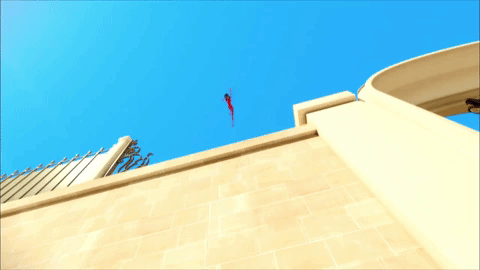
I hope this was helpful! Feel free to add your own tips and if you have any questions or feedback, just ask me or message me - my DMs are always open. Of course, you could just leave a note on here but if you want to be a little fancy, hit me up!
Alsoooo, let me know if you want me to a) do this for essay-based entrance exams and/or b) turn this into a mini-series and apply these steps to different tests like the TSA, LNAT, BMAT, UKCAT, STEP etc. Then all the resources will be in one place. Obviously, I’m not preparing for all of them (doctor who? definitely not me 🤧) but I have some friends doing some of these exams so I can get some extra exclusive tips from them.
Now, carrying on with QOTD:
QOTD: How do you get over exam nerves?
For me, acknowledging that I’m nervous before the exam and that it’s okay before I distract myself makes me feel much calmer. In an actual exam, I usually cover my ears and try and focus on what I’m reading to get out of my head 😅.
PS: This is my first informative post - please don’t judge 🙈! And if you’ve found it helpful, please reblog so that others can see these tips too ☺️.
#new studyblr#100 days of productivity#studyblr masterpost#study tips#studying#stillstudies#primrosestudies#university#university prep#exam#entrance exam#productivity-tips#exam tips#exam hacks#summer studying challenge#eintsein#studyblr masterposts#serendistudy#smartspos#emmastudies#studyblrmasterposts#starrystvdy#athenus#myhoneststudyblr#pancakestudies#etudiance#studyxinn#amorstudying#caffinated-rey#uni
77 notes
·
View notes